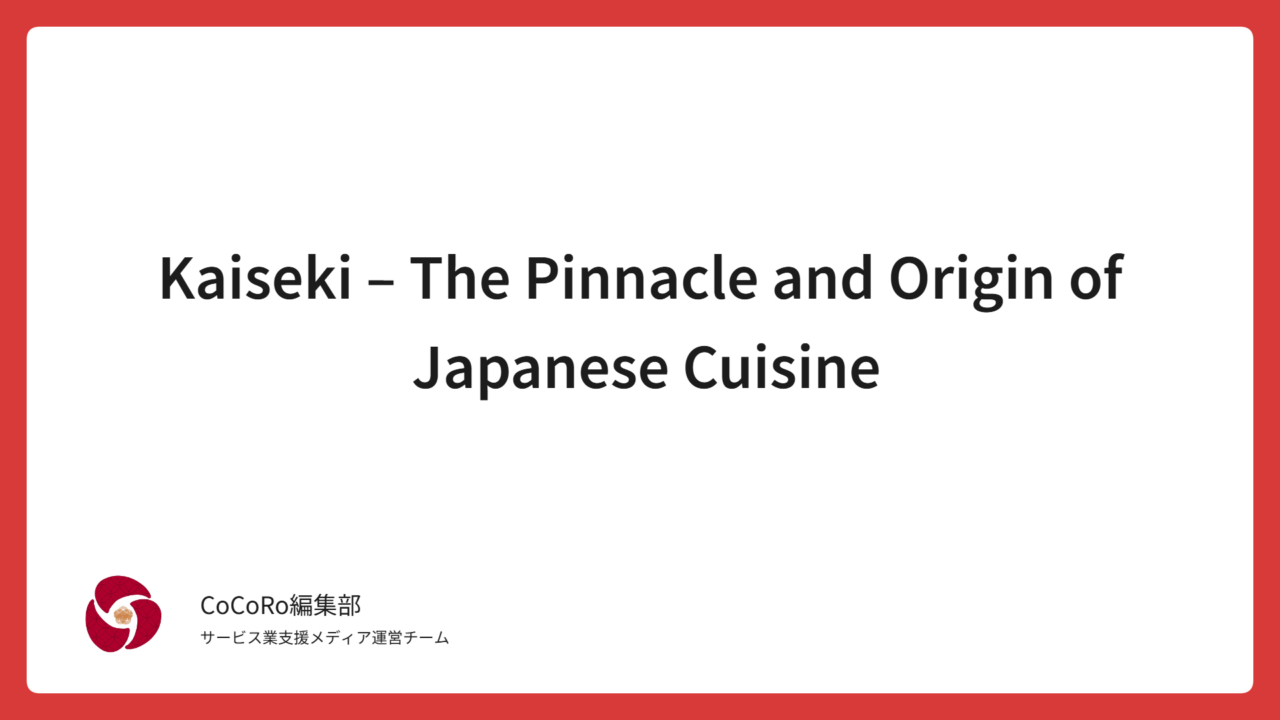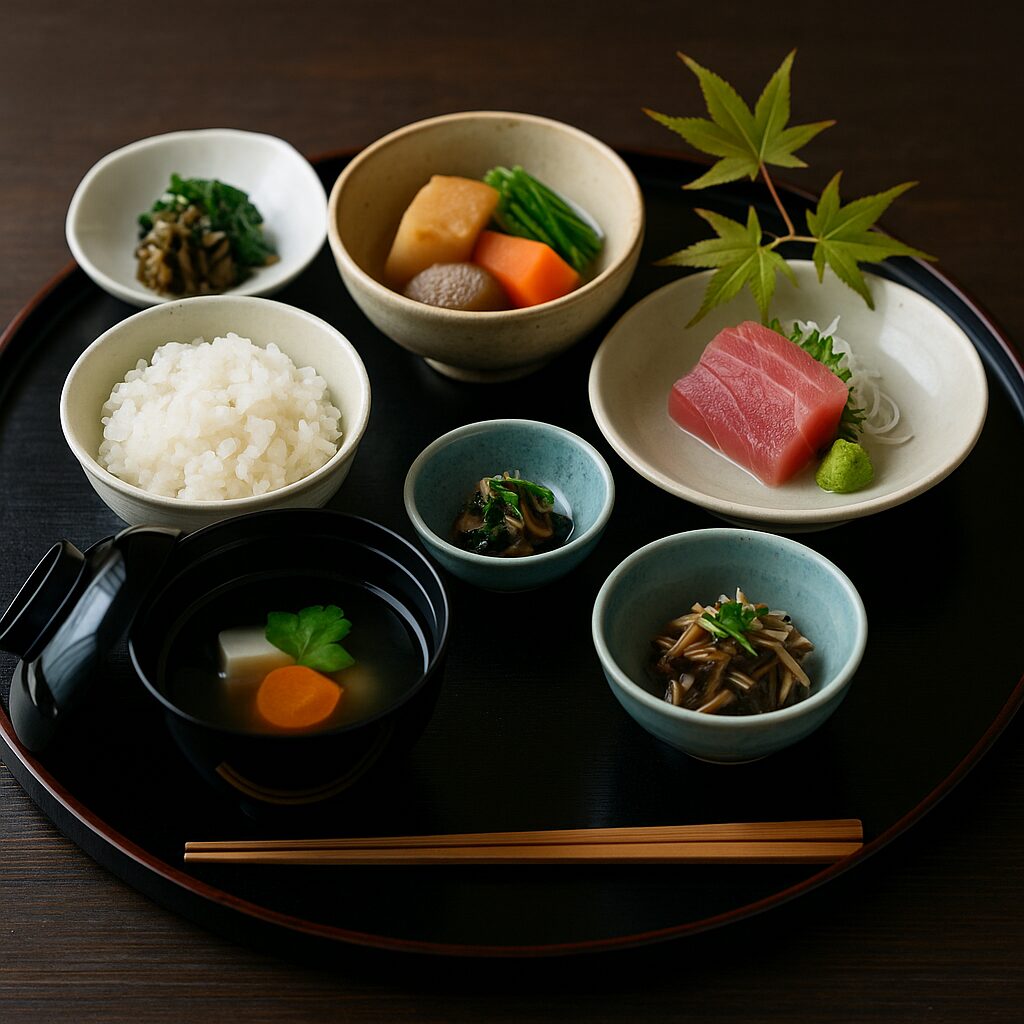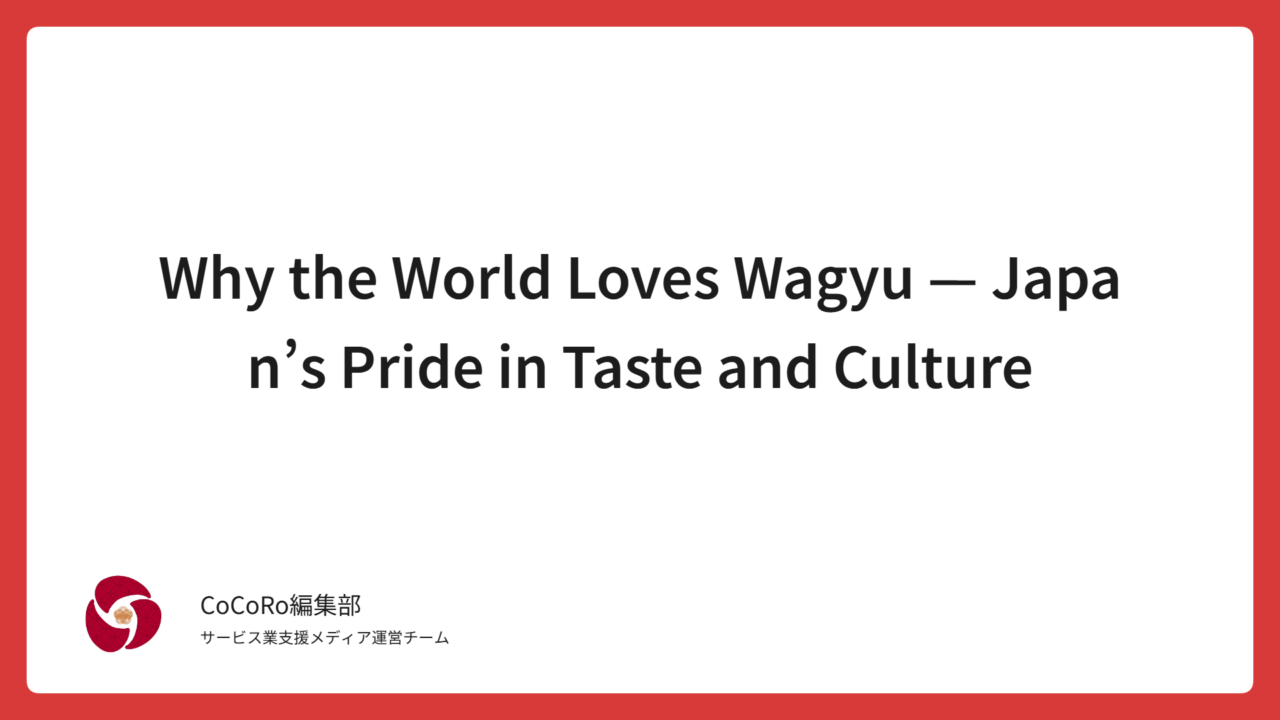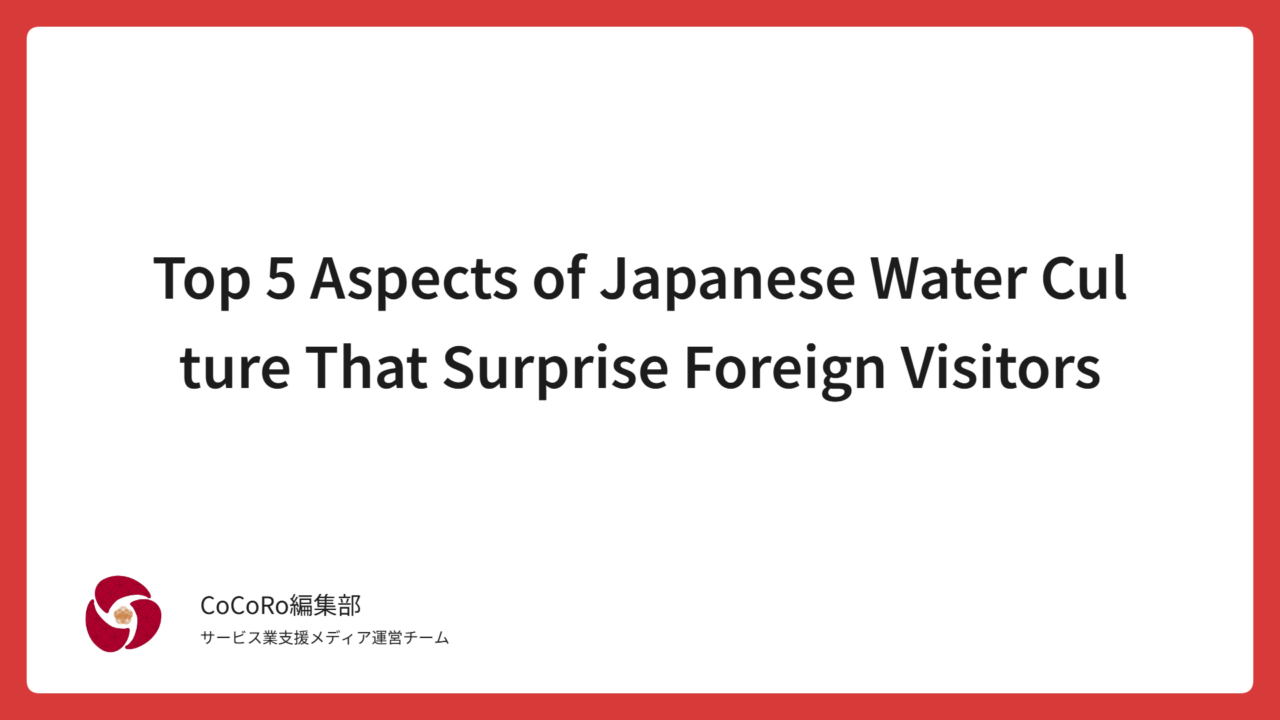

- Chapter 1: What Is Kaiseki? — A Meal to Harmonize, Not to Indulge
- Chapter 2: The History of Kaiseki — The Culture of Tranquility Born from the Way of Tea
- Chapter 3: Cha Kaiseki and Ryotei Kaiseki — The Difference Between Spirit and Form
- Chapter 4: Ichiju Sansai — The Philosophy That Shaped the Structure of Washoku
- Chapter 5: The Essence of Flavor — The Aesthetics of Subtraction, Not Addition
- Chapter 6: The Flow of Kaiseki — A Story That Breathes Through Every Dish
- Chapter 7: The Japanese Spirit Living Within Kaiseki
- Chapter 8: Modern Kaiseki — Unchanging, Yet Ever-Evolving
- Chapter 9: Conclusion — Kaiseki as Both the Pinnacle and the Origin of Washoku
Chapter 1: What Is Kaiseki? — A Meal to Harmonize, Not to Indulge
When people hear the word Kaiseki, they often imagine something luxurious, formal, and delicately portioned.
However, true Kaiseki is not a symbol of extravagance — it is a meal designed to bring harmony to both the body and the mind.
This philosophy lies at the very heart of Japanese cuisine — Washoku.
Washoku is a system of wisdom for living in harmony with nature,
and Kaiseki represents its most refined and elegant expression.
Chapter 2: The History of Kaiseki — The Culture of Tranquility Born from the Way of Tea
The origins of Kaiseki trace back to the 16th century, during the development of the Japanese tea ceremony (Chanoyu).
Sen no Rikyū, who perfected the art of tea, established a simple meal served before tea as Cha Kaiseki — the foundation of what we now call Kaiseki cuisine.
The word Kaiseki carries a profound meaning.
It originates from an old Zen Buddhist practice in which monks would warm a small stone and hold it close to their chest to ease hunger and cold.
In other words, to “hold a warm stone to one’s chest” symbolized an act of soothing the body and calming the mind.
Rikyū adopted this term and redefined it as a meal to prepare and purify the mind before taking tea.
He transformed the idea of a meal from something that simply satisfies the body into something that centers and harmonizes the spirit.
Kaiseki is a meal that warms the heart.
It is not merely “cooking,” but a preparation of the mind.
The Cha Kaiseki meal of that time was simple — a bowl of rice, soup, and a few modest side dishes.
Yet within that simplicity was condensed the Japanese spirit of “knowing contentment” and a deep sense of gratitude toward nature.
This idea — finding beauty within stillness — later became the guiding philosophy of Washoku,
passed down through generations into Ryotei Kaiseki (restaurant-style Kaiseki), Shojin Ryori (Buddhist vegetarian cuisine), and even the everyday meals of Japanese homes.
Chapter 3: Cha Kaiseki and Ryotei Kaiseki — The Difference Between Spirit and Form
In modern times, the term Kaiseki generally refers to the multi-course meals served at traditional restaurants or inns — known as Ryotei Kaiseki.
However, the original Kaiseki was part of the tea ceremony, a completely different world called Cha Kaiseki.
| Category | Cha Kaiseki | Ryotei Kaiseki |
|---|---|---|
| Period of Origin | 16th century (Era of the Tea Ceremony) | Edo to Meiji period and beyond |
| Purpose | To purify and center the mind | To offer hospitality to guests |
| Characteristics | Ichiju Sansai (one soup, three dishes); simple and Zen-inspired | Multi-course; elegant and artistic presentation |
| Focus / Essence | The host’s mindfulness and spiritual consideration | The chef’s craftsmanship and aesthetic performance |
Cha Kaiseki is a “meal of the spirit,” while Ryotei Kaiseki is a “meal of form.”
In other words, Ryotei Kaiseki inherits the spiritual essence of Cha Kaiseki and transforms it into an art form of cuisine.
Chapter 4: Ichiju Sansai — The Philosophy That Shaped the Structure of Washoku
One reason Kaiseki is called the “origin of Washoku” lies in the fact that it established the fundamental structure of Japanese cuisine — Ichiju Sansai, meaning “one soup and three dishes.”
This composition — centered around rice, accompanied by soup and three side dishes — embodies not only visual balance but also the harmony of nature and nutritional equilibrium.
One soup = warms the heart
Three dishes = savor the blessings of nature
Rice = the center of life
This structure lives on today in home-cooked meals and even in the breakfasts served at traditional inns —
a testament to how the spirit of Kaiseki continues to thrive in everyday Japanese life.
Chapter 5: The Essence of Flavor — The Aesthetics of Subtraction, Not Addition
At the heart of Kaiseki cuisine lies dashi — the delicate broth that forms its foundation.
The umami drawn from kombu (kelp), katsuobushi (bonito flakes), and shiitake mushrooms creates subtle layers of flavor unseen in any other culinary tradition.
The art of flavor in Washoku is the opposite of Western cuisine, which often masks ingredients with heavy sauces.
In Kaiseki, flavor is revealed through subtraction — by listening to the natural voice of each ingredient.
- Not to intensify the flavor, but to harmonize it.
- Salt and soy sauce play only supporting roles.
- Temperature, aroma, and space define the flavor.
This “aesthetics of subtraction” shaped not only Kaiseki, but also the broader sensibility of Japanese cuisine — including sushi, tempura, and Shojin Ryori (Buddhist vegetarian cuisine).
Chapter 6: The Flow of Kaiseki — A Story That Breathes Through Every Dish
In Ryotei Kaiseki, the entire course is composed like a single breath — a seamless rhythm from beginning to end.
Each dish carries meaning, reflecting the passing of the seasons and the subtle shifts of the heart.
| Order | Dish Name | Meaning / Symbolism |
|---|---|---|
| Sakizuke | A seasonal appetizer | A greeting — “Welcome.” |
| Wanmono | Clear soup | The essence of dashi — the heart of Kaiseki. |
| Mukozuke | Sashimi | A symbol of life. |
| Yakimono | Grilled fish or meat | Strength and aroma. |
| Takiawase | Simmered vegetables or tofu | Gentleness and harmony. |
| Agemono | Deep-fried dish, such as tempura | A light and playful transition. |
| Sunomono | Vinegared dish | A palate cleanser that resets the senses. |
| Gohan, Shiru, Kounomono | Rice, soup, and pickles | A quiet return to the center — the stillness of the heart. |
| Mizugashi | Seasonal fruit or sweets | Gratitude toward nature. |
Rice is served at the end to bring one back to the center of life.
In this moment, we can still see how the Japanese have long regarded eating not merely as an act, but as a form of prayer.
Chapter 7: The Japanese Spirit Living Within Kaiseki
What makes Kaiseki fundamentally different from other world cuisines is that it values how one eats more than what one eats.
At the heart of it are four fundamental principles.
- Respect the Seasons — Savor the moment of each harvest and live in harmony with nature.
- Express Gratitude — “Itadakimasu” is a prayer for life itself.
- Practice Moderation — To know contentment.
- Seek Harmony — Align people with nature, and the mind with the body.
Kaiseki is not only about taste — it is a culinary culture that teaches a way of life.
Chapter 8: Modern Kaiseki — Unchanging, Yet Ever-Evolving
Today, Kaiseki is no longer a privilege reserved for the few.
It is served in traditional inns, hotels, and even Japanese restaurants abroad,
and is being rediscovered as a culinary experience that embodies the essence of Japan.
At the same time, today’s chefs incorporate wine pairings and fusion techniques,
while staying true to the essence of Kaiseki — harmony and heartfelt consideration.
Kaiseki is not a relic of the past — it is a living tradition.
Chapter 9: Conclusion — Kaiseki as Both the Pinnacle and the Origin of Washoku
Kaiseki is not merely a form of cuisine.
It is a culinary art that embodies the Japanese sense of beauty and spirit.
- Cha Kaiseki is the origin — a meal to center and calm the heart.
- Ryotei Kaiseki is the culmination — the point where spirit takes form.
Flowing through both is an eternal message —
that eating is an act of gratitude and harmony.
To know Kaiseki is to understand Washoku.
To understand Washoku is to glimpse the heart of the Japanese people.
だからこそ――
Kaiseki is both the pinnacle and the origin of Washoku.






